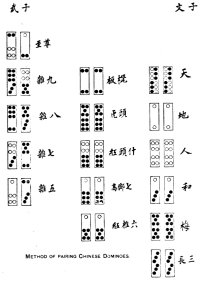
Dominoes are regularly used in fortune telling in China at the present day, and their use for this purpose is generally known to the laborers who come to America.
I have before me a book entitled Ngá p'ái shan shò t'ò chü ts'éung kái, "a chart for finding out the numbers by divine aid and with ivory dominoes, with an explanation and commentary." This work was printed in Canton in 1865, the name of the author being given as Ch'ing Ngok.
The preface, which professes to explain the attributes and astrological significance of the dominoes, is followed by a series of diagrams illustrating different combinations formed with dominoes taken three, or in one class, two at a time. Specimens of the different classes are represented in Plate 7.
The following names and numerical value: are given to them:
pat t'ung, "unlike," counts 6
hòp háu "ingeniously divided," counts 4
'ng tsz', "five spots," counts 5
fan shéung, "divided reciprocally," counts 3
má kuan, "cavalry," counts 3
í sám luk, "two, three, six," counts 3
iú í sam, "ace, two, three," counts 3
túi tsz', "corresponding spots," counts 3
ching fái, "correctly satisfied," counts 1.
In telling fortunes an entire set of dominoes is placed face down upon a table and well mixed. The dominoes are then all placed side by side in a row and reversed. The manipulator selects from this row as many [Page 518] combinations as possible, formed by adjacent pieces, according to the diagrams, and adds together the numbers corresponding with them. This sum is referred to the following table and result noted:
1 to 4 is to be esteemed há há, "lowest"
5 to 7 is to be esteemed chung há, "below the middle"
8 to 9 is to be esteemed chung p'ing, "even middle"
10 to 11 is to be esteemed shéung shéung, "highest"
The dominoes are then reversed again and mixed, and the preceding operations twice repeated, and 3 sets of terms from the above series obtained. Reference is then made to the text of the book. This consists of 125 pages, arranged in order under all the different combinations that may be formed with the 5 pairs of terms given above, taken 3 pairs at a time, commencing with shéung shéung, shéung shéung, shéung shéung. An oracular verse, apparently of original composition, is found on each page, referring to some well-known personage or incident, with a short text to aid the diviner in applying the prognostication to the various affairs of life.
Last update January 31, 2010